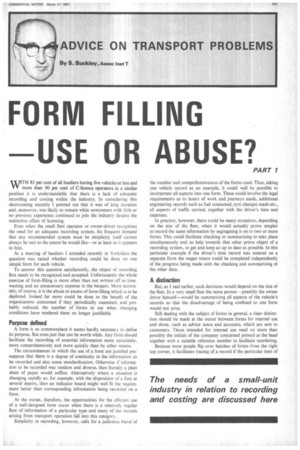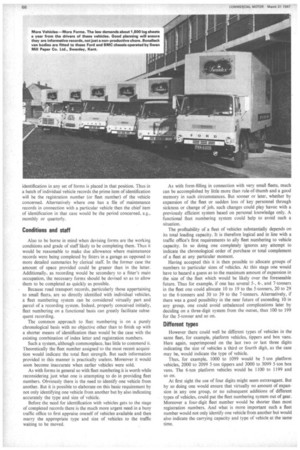FORM FILLING USE OR ABUSE? PART
Page 67

Page 68

If you've noticed an error in this article please click here to report it so we can fix it.
WTH 85 per cent of all hauliers having five vehicles or less and more than 90 per cent of C-licence operators in a similar position it is understandable that there is a lack of adequate recording and costing within the industry. In considering this shortcoming recently I pointed out that it was of long duration and, moreover, was likely to remain while newcomers with little or no previous experience continued to•join the industry despite the restrictive effect of licensing.
Even when the small fleet operator or owner-driver recognizes the need for an adequate recording system, his frequent demand that any recommended system must be simplicity itself cannot always be met to the extent he would like—or at least so it appears to him.
At a meeting of hauliers I attended recently in Yorkshire the question was raised whether recording could be done on one simple form for each vehicle.
To answer this question satisfactorily, the object of recording first needs to be recognized and accepted. Unfortunately the whole exercise of form-filling is more often than not written off as timewasting and an unnecessary expense in the bargain. More accurately, of course, it is the abuse or excess of form-filling which is to be deplored. Indeed far more could be done to the benefit of the organizations concerned if they periodically examined, and probably reduced, the number of forms in use when changing conditions have rendered them no longer justifiable.
Purpose defined
A form is so commonplace it seems hardly necessary to define its purpose. But even just that can be worth while. Any form should facilitate the recording of essential information more accurately, more comprehensively and more quickly than by other means.
The circumstances in which the use of a form are justified presuppose that there is a degree of continuity in the information to be recorded and also some standardization. Otherwise if information to be recorded was random and diverse, then literally a plain sheet of paper would suffice. Alternatively where a situation is changing rapidly as, for example, with the disposition of a fleet at several depots, then an indicator board might well fit the requirement better than corresponding information being recorded on a form.
At the outset, therefore, the opportunities for the efficient use of a well-designed form occur when there is a relatively regular flow of information of a particular type and many of the records arising from transport operation fall into this category.
Simplicity in recording, however, calls for a judicious blend of the number and comprehensiveness of the forms used. Thus, taking one vehicle record as an example, it could well be possible to incorporate all aspects into one form. These could involve the legal requirements as to hours of work and journeys made, additional engineering records such as fuel consumed, tyre changes made etc., all aspects of traffic carried, together with the driver's time and expenses.
In practice, however, there could be many occasions, depending on the size of the fleet, when it would actually prove simpler to record the same information by segregating it on to two or more forms. This could facilitate checking or summarizing to take place simultaneously and so help towards that other prime object of a recording system, to get and keep as up to date as possible. In this particular example if the driver's time record was entered on a separate form the wages return could be completed independently of the progress being made with the checking and summarizing ot' the other data.
A distinction
But, as I said earlier, such decisions would depend on the size of the fleet. In a very small fleet the same person—possibly the owner driver himself—would be summarizing all aspects of the vehicle's records so that the disadvantage of being confined to one form would not arise.
Still dealing with the subject of forms in general, a clear distinction should be made at the outset between forms for internal use and those, such as advice notes and accounts, which are sent to customers. Those intended for internal use need no more than possibly the initials of the company concerned printed at the head together with a suitable reference number to facilitate reordering.
Because most people flip over batches of forms from the right top corner, it facilitates tracing of a record if the particular item of identification in any set of forms is placed in that position. Thus in a batch of individual vehicle records the prime item of identification will be the registration number (or fleet number) of the vehicle concerned. Alternatively where one has a file of maintenance records in connection with a particular vehicle then the chief item of identification in that case would be the period concerned, e.g., monthly or quarterly.
Conditions and staff
Also to be borne in mind when devising forms are the working conditions and grade of staff likely to be completing them. Thus it would be reasonable to make due allowance where maintenance records were being completed by fitters in a garage as opposed to more detailed summaries by clerical staff. In the former case the amount of space provided could be greater than in the latter. Additionally, as recording would be secondary to a fitter's main occupation, the necessary forms should be devised so as to allow them to be completed as quickly as possible.
Because road transport records, particularly those appertaining to small fleets, are so directly identified with individual vehicles, a fleet numbering system can be considered virtually part and parcel of a recording system. Indeed, properly conceived initially, fleet numbering on a functional basis can greatly facilitate subsequent recording.
The common _approach to fleet numbering is on a purely chronological basis with no objective other than to finish up with a shorter means of identification than would be the case with the existing combination of index letter and registration numbers.
Such a system, although commonplace, has little to commend it. Theoretically the fleet number assigned to the most recent acquisition would indicate the total fleet strength. But such information provided in this manner is practically useless. Moreover it would soon become inaccurate when earlier vehicles were sold.
As with forms in general so with fleet numbering it is worth while reconsidering just what one is attempting to do in providing fleet numbers. Obviously there is the need to identify one vehicle from another. But it is possible to elaborate on this basic requirement by not only identifying one vehicle from another but by also indicating accurately the type and size of vehicle.
Before the need for identification with vehicles gets to the stage of completed records there is the much more urgent need in a busy traffic office to first appraise oneself of vehicles available and then marry the appropriate type and size of vehicles to the traffic waiting to be moved. As with form-filling in connection with very small fleets, much can be accomplished by little more than rule-of-thumb and a good memory in such circumstances. But sooner or later, whether by expansion of the fleet or sudden loss of key personnel through sickness or change of job, such changes could play havoc with a previously efficient system based on personal knowledge only. A functional fleet numbering system could help to avoid such a situation.
The profitability of a fleet of vehicles substantially depends on its total loading capacity. It is therefore logical and in line with a traffic office's first requirements to ally fleet numbering to vehicle capacity. In so doing one completely ignores any attempt to indicate the chronological order of purchase or total complement of a fleet at any particular moment.
Having accepted this it is then possible to allocate groups of numbers to particular sizes of vehicles. At this stage one would have to hazard a guess as to the maximum amount of expansion in the size of the fleet which would be likely over the foreseeable future. Thus for example, if one has several 5-, 6-, and 7-tonners in the fleet one could allocate 10 to 19 to the 5-tonners, 20 to 29 to the 6-tonners and 30 to 39 to the 7-tonners. Alternatively, if there was a good possibility in the near future of exceeding 10 in any group, one could avoid unbalanced complications later by deciding on a three-digit system from the outset, thus 100 to 199 for the 5-tonner and so on.
Different types
However there could well be different types of vehicles in the same fleet, for example, platform vehicles, tippers and box vans. Here again, superimposed on the last two or last three digits indicating the size of vehicles a third or fourth digit, as the case may be, would indicate the type of vehicle.
Thus, for example, 1000 to 1099 would be 5-ton platform vehicles, 2000 to 2099 5-ton tippers and 3000 to 3099 5-ton box vans. The 6-ton platform vehicles would be 1100 to 1199 and so on.
At first sight the use of four digits might seem extravagant. But by so doing one would ensure that virtually no amount of expansion in any one group, or no subsequent additions of different types of vehicles, could put the fleet numbering system out of gear. Moreover a four-digit fleet number would be shorter than most registration numbers. And what is more important such a fleet number would not only identify one vehicle from another but would also indicate the carrying capacity and type of vehicle at the same time.
















































































































